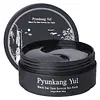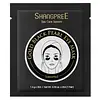What's inside
What's inside
 Key Ingredients
Key Ingredients

 Benefits
Benefits

 Concerns
Concerns

 Ingredients Side-by-side
Ingredients Side-by-side

Water
Skin ConditioningGlycerin
HumectantNiacinamide
SmoothingChondrus Crispus Extract
Skin ConditioningCeratonia Siliqua Gum
EmollientCellulose Gum
Emulsion Stabilising1,2-Hexanediol
Skin ConditioningHydroxyacetophenone
AntioxidantSucrose
HumectantPotassium Chloride
Calcium Aluminum Borosilicate
CI 77499
Cosmetic ColorantSaccharomyces/Xylinum/Black Tea Ferment
Skin ConditioningAllantoin
Skin ConditioningXanthan Gum
EmulsifyingCoptis Chinensis Root Extract
AntioxidantEthylhexylglycerin
Skin ConditioningSilica
AbrasiveAdenosine
Skin ConditioningCI 77891
Cosmetic ColorantBis-PEG-15 Methyl Ether Dimethicone
EmulsifyingDisodium EDTA
Mica
Cosmetic ColorantDipotassium Glycyrrhizate
HumectantGlycine Max Seed Extract
Skin ConditioningBetula Alba Leaf Extract
AstringentPolyglyceryl-6 Caprylate
EmulsifyingPolyglyceryl-4 Caprate
EmulsifyingSodium Polyacryloyldimethyl Taurate
Emulsion StabilisingButylene Glycol
HumectantCamellia Sinensis Leaf Extract
AntimicrobialOryza Sativa Bran Extract
Skin ConditioningPearl Extract
AntioxidantMelaleuca Alternifolia Leaf Extract
PerfumingTin Oxide
AbrasivePropanediol
SolventHydrolyzed Collagen
EmollientCeramide NP
Skin ConditioningGlyceryl Polymethacrylate
Tocopherol
AntioxidantHydrolyzed Glycosaminoglycans
HumectantSodium Hyaluronate
HumectantPropylene Glycol
HumectantSodium Hyaluronate Crosspolymer
HumectantHydrolyzed Hyaluronic Acid
HumectantHydroxypropyltrimonium Hyaluronate
Hyaluronic Acid
HumectantSodium Acetylated Hyaluronate
HumectantPalmitoyl Tripeptide-1
Skin ConditioningWater, Glycerin, Niacinamide, Chondrus Crispus Extract, Ceratonia Siliqua Gum, Cellulose Gum, 1,2-Hexanediol, Hydroxyacetophenone, Sucrose, Potassium Chloride, Calcium Aluminum Borosilicate, CI 77499, Saccharomyces/Xylinum/Black Tea Ferment, Allantoin, Xanthan Gum, Coptis Chinensis Root Extract, Ethylhexylglycerin, Silica, Adenosine, CI 77891, Bis-PEG-15 Methyl Ether Dimethicone, Disodium EDTA, Mica, Dipotassium Glycyrrhizate, Glycine Max Seed Extract, Betula Alba Leaf Extract, Polyglyceryl-6 Caprylate, Polyglyceryl-4 Caprate, Sodium Polyacryloyldimethyl Taurate, Butylene Glycol, Camellia Sinensis Leaf Extract, Oryza Sativa Bran Extract, Pearl Extract, Melaleuca Alternifolia Leaf Extract, Tin Oxide, Propanediol, Hydrolyzed Collagen, Ceramide NP, Glyceryl Polymethacrylate, Tocopherol, Hydrolyzed Glycosaminoglycans, Sodium Hyaluronate, Propylene Glycol, Sodium Hyaluronate Crosspolymer, Hydrolyzed Hyaluronic Acid, Hydroxypropyltrimonium Hyaluronate, Hyaluronic Acid, Sodium Acetylated Hyaluronate, Palmitoyl Tripeptide-1
Water
Skin ConditioningGlycerin
HumectantCarrageenan
Butylene Glycol
HumectantSodium Hyaluronate
HumectantAcer Saccharum Extract
Skin ConditioningGentiana Lutea Root Extract
Skin ConditioningArtemisia Absinthium Extract
Skin ConditioningCucumis Sativus Fruit Extract
EmollientRosa Damascena Extract
MaskingEthylhexylglycerin
Skin ConditioningAloe Barbadensis Leaf Extract
EmollientCitrus Aurantifolia Fruit Extract
Skin ConditioningCitrus Limon Fruit Extract
MaskingPyrus Malus Fruit Extract
Skin ConditioningMentha Rotundifolia Leaf Extract
TonicPearl Extract
AntioxidantBetaine
HumectantCitrus Grandis Seed Extract
AstringentBambusa Textilis Stem Extract
Skin ConditioningPinus Palustris Leaf Extract
TonicCI 77480
Cosmetic ColorantCyamopsis Tetragonoloba Gum
Emulsion StabilisingPotassium Chloride
Ceratonia Siliqua Gum
EmollientSucrose
HumectantPEG-60 Hydrogenated Castor Oil
EmulsifyingCalcium Chloride
AstringentAllantoin
Skin ConditioningCaffeine
Skin ConditioningCellulose Gum
Emulsion StabilisingChondrus Crispus Powder
AbrasiveTitanium/Titanium Dioxide
Cosmetic ColorantRicinus Communis Seed Oil
MaskingMica
Cosmetic ColorantTin Oxide
AbrasiveCI 77491
Cosmetic ColorantTitanium Dioxide
Cosmetic ColorantCalcium Lactate
AstringentDisodium EDTA
Dipotassium Glycyrrhizate
HumectantPropanediol
SolventPentylene Glycol
Skin ConditioningCocos Nucifera Fruit Extract
EmollientPinus Sylvestris Leaf Extract
TonicEthyl Hexanediol
Solvent1,2-Hexanediol
Skin ConditioningHexylene Glycol
EmulsifyingHydroxyacetophenone
AntioxidantChlorphenesin
AntimicrobialParfum
MaskingWater, Glycerin, Carrageenan, Butylene Glycol, Sodium Hyaluronate, Acer Saccharum Extract, Gentiana Lutea Root Extract, Artemisia Absinthium Extract, Cucumis Sativus Fruit Extract, Rosa Damascena Extract, Ethylhexylglycerin, Aloe Barbadensis Leaf Extract, Citrus Aurantifolia Fruit Extract, Citrus Limon Fruit Extract, Pyrus Malus Fruit Extract, Mentha Rotundifolia Leaf Extract, Pearl Extract, Betaine, Citrus Grandis Seed Extract, Bambusa Textilis Stem Extract, Pinus Palustris Leaf Extract, CI 77480, Cyamopsis Tetragonoloba Gum, Potassium Chloride, Ceratonia Siliqua Gum, Sucrose, PEG-60 Hydrogenated Castor Oil, Calcium Chloride, Allantoin, Caffeine, Cellulose Gum, Chondrus Crispus Powder, Titanium/Titanium Dioxide, Ricinus Communis Seed Oil, Mica, Tin Oxide, CI 77491, Titanium Dioxide, Calcium Lactate, Disodium EDTA, Dipotassium Glycyrrhizate, Propanediol, Pentylene Glycol, Cocos Nucifera Fruit Extract, Pinus Sylvestris Leaf Extract, Ethyl Hexanediol, 1,2-Hexanediol, Hexylene Glycol, Hydroxyacetophenone, Chlorphenesin, Parfum
 Reviews
Reviews

Ingredients Explained
These ingredients are found in both products.
Ingredients higher up in an ingredient list are typically present in a larger amount.
1,2-Hexanediol is a synthetic liquid and another multi-functional powerhouse.
It is a:
- Humectant, drawing moisture into the skin
- Emollient, helping to soften skin
- Solvent, dispersing and stabilizing formulas
- Preservative booster, enhancing the antimicrobial activity of other preservatives
Allantoin is a soothing ingredient known for its protective and moisturizingg properties. Because of this, it is often added to products with strong active ingredients.
Studies show higher concentrations of this ingredient can promote wound healing.
Though it can be derived from the comfrey plant, allantoin is produced synthetically for cosmetic products to ensure purity.
Learn more about AllantoinButylene Glycol (or BG) is used within cosmetic products for a few different reasons:
Overall, Butylene Glycol is a safe and well-rounded ingredient that works well with other ingredients.
Though this ingredient works well with most skin types, some people with sensitive skin may experience a reaction such as allergic rashes, closed comedones, or itchiness.
Learn more about Butylene GlycolCellulose Gum is a water-soluble polymer that comes from cellulose. It is used to change the texture of a product and to help stabilize emulsions.
As an emulsifier, cellulose gum specifically thicken the texture of water-based products.
This ingredient is considered hypoallergenic and non-toxic. Cellulose Gum can be found in cosmetics, food, and other household goods such as paper products.
Learn more about Cellulose GumCeratonia Siliqua Gum is extracted from the seeds of the carob tree. You might know this ingredient as Carob Gum or Locust Bean Gum. It is used to stabilize other ingredients and improve the texture of products.
Carob gum is made up of long-chain polysaccharides. This makes it a natural thickener.
Yes! This ingredient comes from the seeds of a tree. The name 'Locust Bean Gum' can be misleading.
Learn more about Ceratonia Siliqua GumDipotassium Glycyrrhizate comes from licorice root.
Extracts of licorice have demonstrated to have antibacterial, anti‐inflammatory, antiviral, antioxidant properties.
One component, glabridin, has extra potent antioxidant and soothing properties. It has also been found to block pigmentation from UVB rays in guinea pigs.
Licorice Root also contains a flavonoid. Flavonoids are a natural substance from in plants. Flavonoids also have antioxidant properties.
Another component, glycyrrhizin, has been found to have anti-inflammatory and antimicrobial benefits. This may make licorice root extract effective at treating acne. However, more research is needed to support this.
Liquiritin is one of the flavone compounds found in licorice. It has been found to help lighten skin by preventing tyrosinase from reacting with tyrosine. When the two react, protein is converted to melanin. Melanin is the substance in your body that gives your features pigmentation.
Licorice root is native to Southern Europe and Asia. It has been used in traditional Chinese medicine to help with respiratory issues.
Learn more about Dipotassium GlycyrrhizateDisodium EDTA plays a role in making products more stable by aiding other preservatives.
It is a chelating agent, meaning it neutralizes metal ions that may be found in a product.
Disodium EDTA is a salt of edetic acid and is found to be safe in cosmetic ingredients.
Learn more about Disodium EDTAEthylhexylglycerin (we can't pronounce this either) is commonly used as a preservative and skin softener. It is derived from glyceryl.
You might see Ethylhexylglycerin often paired with other preservatives such as phenoxyethanol. Ethylhexylglycerin has been found to increase the effectiveness of these other preservatives.
Glycerin is already naturally found in your skin. It helps moisturize and protect your skin.
A study from 2016 found glycerin to be more effective as a humectant than AHAs and hyaluronic acid.
As a humectant, it helps the skin stay hydrated by pulling moisture to your skin. The low molecular weight of glycerin allows it to pull moisture into the deeper layers of your skin.
Hydrated skin improves your skin barrier; Your skin barrier helps protect against irritants and bacteria.
Glycerin has also been found to have antimicrobial and antiviral properties. Due to these properties, glycerin is often used in wound and burn treatments.
In cosmetics, glycerin is usually derived from plants such as soybean or palm. However, it can also be sourced from animals, such as tallow or animal fat.
This ingredient is organic, colorless, odorless, and non-toxic.
Glycerin is the name for this ingredient in American English. British English uses Glycerol/Glycerine.
Learn more about GlycerinHydroxyacetophenone is antioxidant with skin conditioning and soothing properties. It also boosts the efficiency of preservatives.
This ingredient is not irritating or sensitizing.
Mica is a naturally occurring mineral used to add shimmer and color in cosmetics. It can also help improve the texture of a product or give it an opaque, white/silver color.
Serecite is the name for very fine but ragged grains of mica.
This ingredient is often coated with metal oxides like titanium dioxide. Trace amounts of heavy metals may be found in mica, but these metals are not harmful in our personal products.
Mica has been used since prehistoric times throughout the world. Ancient Egyptian, Indian, Greek, Roman, Aztec, and Chinese civilizations have used mica.
Learn more about MicaPearl Extract comes from, well, pearls. Pearls are harvested from oysters.
Pearls are rich in amino-acids, magnesium, potassium, calcium, and antioxidant compounds.
Two antioxidants found in pearls include: superoxide dismutase (SOD) and glutathione. Antioxidants aid in reducing the signs of aging.
Studies show pearls can aid in wound healing.
Pearls are harvested from oysters. To be vegan, an ingredient cannot be from an animal source.
Learn more about Pearl ExtractPotassium Chloride can be bad for oily skin and be bad for acne prone skin.
Propanediol is an all-star ingredient. It softens, hydrates, and smooths the skin.
It’s often used to:
Propanediol is not likely to cause sensitivity and considered safe to use. It is derived from corn or petroleum with a clear color and no scent.
Learn more about PropanediolSodium Hyaluronate is hyaluronic acid's salt form. It is commonly derived from the sodium salt of hyaluronic acid.
Like hyaluronic acid, it is great at holding water and acts as a humectant. This makes it a great skin hydrating ingredient.
Sodium Hyaluronate is naturally occurring in our bodies and is mostly found in eye fluid and joints.
These are some other common types of Hyaluronic Acid:
Learn more about Sodium HyaluronateSucrose is a natural sugar found in fruits, vegetables, and nuts. It is the main constituent of white sugar.
In skincare, sucrose is a humectant and can be a mild exfoliant.
Sucrose is hydrophilic, meaning it attracts water. This makes it an effective humectant and helps hydrate the skin.
Studies show sugars may worsen acne-prone skin due to it disrupting the skin's natural biome. We recommend speaking with a professional if you have any concerns.
In some products such as body scrubs, sucrose is used as an gentle exfoliant.
The term 'sucrose' comes from the french word for sugar, 'sucre'.
Learn more about SucroseTin Oxide is an inorganic oxide used to add opacity and volume to a product. In nature, it is already found in mineral form. The main ore of tin is an opaque and shiny mineral called casseterite.
Tin Oxide helps remove translucency in a product, or make it more opaque. Besides adding opacity, tin oxide is used for bulking to add volume.
Water. It's the most common cosmetic ingredient of all. You'll usually see it at the top of ingredient lists, meaning that it makes up the largest part of the product.
So why is it so popular? Water most often acts as a solvent - this means that it helps dissolve other ingredients into the formulation.
You'll also recognize water as that liquid we all need to stay alive. If you see this, drink a glass of water. Stay hydrated!
Learn more about Water